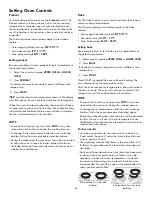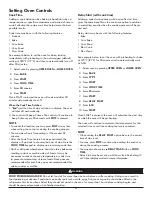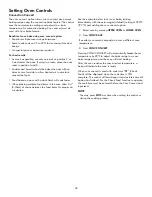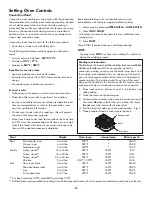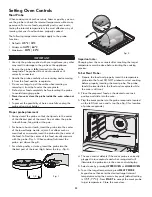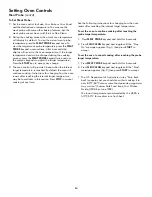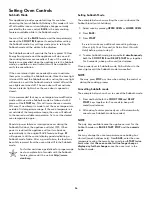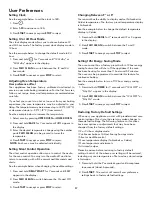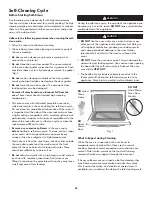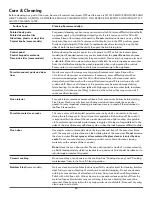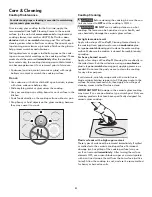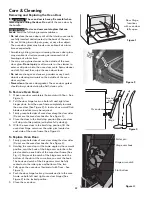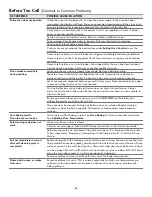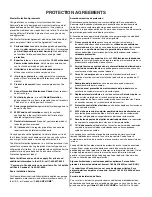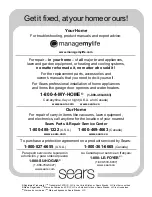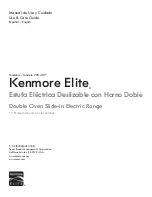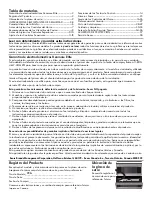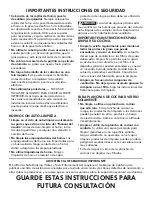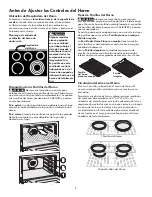
30
care & cleaning
Surface Type
Cleaning Recommendation
Painted body parts,
Painted decorative trim
aluminum, plastic or vinyl trim
control knobs (some models)
For general cleaning, use hot, soapy water and a cloth. For more diffi cult soils and built-
up grease, apply a liquid detergent directly onto the soil. Leave on soil for 30 to 60
minutes. Rinse with a damp cloth and dry.
Do not
use abrasive cleaners on any of these
materials; they can scratch. To remove control knobs, turn to the OFF position; grasp
fi rmly and pull straight off the shaft. To replace knobs after cleaning, line up the fl at
sides of both the knob and the shaft; then push the knob into place.
Control panel
Control keypad membrane
Decorative trim (some models)
Before cleaning the control panel, turn all controls to OFF, active the lockouts (some
models) and if needed remove any control knobs from the panel.
Do not
use abrasive
cleaners on any of these materials; they can scratch. Clean using hot, soapy water and
a dishcloth. Rinse with a clean water using a dishcloth. Be sure to squeeze excess water
from the cloth before wiping the panel; especially when wiping around the controls.
Excess water in or around the controls may cause damage to the appliance.
Porcelain enamel parts and door
liner
Gentle scouring with a soapy scouring pad will remove most spots. Rinse with a
1:1 solution of clear water and ammonia. If necessary, cover diffi cult spots with an
ammonia-soaked paper towel for 30 to 40 minutes. Rinse with clean water and a
damp cloth, and then scrub with a soap-fi lled scouring pad. Rinse and wipe dry with
a clean cloth. Remove all cleaners or the porcelain may become damaged during
future heating. Do no allow food spills with high sugar or acid content (milk, tomatoes,
sauerkraut, fruit juices or pie fi lling) to remain on the surface; they may cause a dull
spot even after cleaning.
Oven interior
For oven interior, remove excessive spillovers from oven cavity bottom before starting
Flex Clean. Clean any soils from oven frame and door liner outside the oven door
gasket. For very important cleaning precautions, be sure to read all the instructions in
the Flex Clean section.
Porcelain coated oven racks
This oven comes with lubricated porcelain oven racks, which can remain in the oven
during the self-clean cycle. Do not clean this vegetable oil lubrication off the racks. It
is important that the sides of the oven racks always have a light coating of vegetable
oil. To maintain optimal rack performance, re-apply a thin layer of vegetable oil to the
sides of the rack after every self-clean cycle or when the rack becomes diffi cult to slide.
Oven door
Use soap & water to thoroughly clean the top, sides and front of the oven door. Rinse
well. You may use a glass cleaner on the outside glass of the oven door.
Do not
immerse
the door in water.
Do not spray or allow water or the glass cleaner to enter the door
vents.
Do not use oven cleaners, cleaning powders or any harsh abrasive cleaning
materials on the outside of the oven door.
Do not
clean the oven door gasket. The oven door gasket is made of a woven material,
on Self-Cleaning models, which is essential for a good seal. Care should be taken not to
rub, damage or remove this gasket.
Ceramic cooktop
Do not use spray oven cleaners on the cooktop. See “Cooktop cleaning” and “Cooktop
maintenance” later in the Care & Cleaning section.
Stainless Steel
(some models)
Only use cleaners and polishes that are specifi cally manufactured for cleaning stainless
steel. Always wipe in direction of metal grain to avoid damaging. Do not use cleaners
with high concentrations of chlorides or chlorine. Do not use harsh scrubbing cleaners.
Polish with a lint-free cloth. Always be sure to wipe excess cleaner/polish off from the
metal surface as bluish stains may occur during future oven heating that cannot be
removed. Clean heavier soils with hot, soapy water and a dishcloth. Rinse and dry using
clean water and a cloth.
Before cleaning any part of the oven, be sure all controls are turned OFF and the oven is COOL. REMOVE SPILLOVERS AND
HEAVY SOILING AS SOON AS POSSIBLE. REGULAR CLEANINGS NOW WILL REDUCE THE EXTENT AND DIFFICULTY OF
MAJOR CLEANING LATER.

